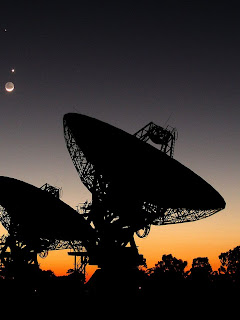The question seems almost too shallow and silly and trivial even to ask. Why is it dark at night?
The answers my family gave me were typical, such as, "The sun has gone to bed and pulled down the nightshade".
Thanks guys! But in reality, the question is very deep and subtle.
On a moonless night, the sky is dark, apart from the light of the stars (let's ignore the planets). The starlight we see comes from the several hundred billion stars in our single galaxy — known as the Milky Way — as well as from the stars in the several hundred billion galaxies out there in our universe.
That is a huge number of stars, and if you add them all up, they emit a lot of starlight.
Let's use a simple example. Think of each star as being a tree, and imagine that you are in a clearing in a forest, and that you look only horizontally (not up, and not down).
When you look north or south, east or west, or any direction in between, you will always see a tree trunk.
In the same way, with thousands of billions of billions of stars in the sky, wherever you look, your nocturnal gaze should always land on a star. And so, the night sky should blaze with a continuous blanket of intense light. But it doesn't.
This question has bothered astronomers for centuries, beginning with the English mathematician and astronomer, Thomas Digges, in 1576. Many astronomers worried about this, including Kepler, Halley, and then Heinrich Olbers in 1823.
For various reasons, this problem became known as Olbers' Paradox.
Olbers suggested that most of the starlight was absorbed by gas and dust between the stars. Going back to our example of the forest, a fog would obscure the more distant trees, with foggy gaps in between, so that all we can see are the closest trees.
Unfortunately, this solution didn't work, because the gas and dust would get hot enough to glow.
Other suggestions that also don't solve this problem include the theories that nearby stars block the light from distant stars, that the stars are grouped into clusters, that the universe is expanding, and so on.
Edward R. Harrison gives a very nice summary of 15 possible solutions in his book, Cosmology, The Science of The Universe.
Yes, if the universe is infinitely old, and is infinitely large and has stars everywhere, then the night sky should be filled with stars.
But when we look, the night sky is full of darkness, relieved by relatively few stars. There's a bunch of reasons.
First, the universe that we can see is not infinitely old, but only about 13.7 billion years old.
Second, the universe is not infinitely large. The observable universe reaches out some 46 billion light-years.
Third, stars do not shine forever. Instead, they typically burn out after several billion years. So, some of the distant stars have already switched off even though their light is still travelling towards us.
Fourth, light takes actual time to get to us. For example, we see the Sun as it was eight minutes ago, the nearest night stars as they were four years ago, and the Andromeda galaxy as it was two million years ago.
This means that the light from some more distant and younger stars has not yet reached us.
So let's finish off by going back to our clearing in the forest, where we imagine each star to be a tree. We are ringed by an inner circle of fairly old trees. Then, as we go outwards, around this inner circle are rings of progressively younger trees, and then a band of seedlings, and finally, a vast treeless plain.
So the trees (and the stars) have gaps between them, which is why it's dark at night.
The problem of day and night is not as simple as black and white. After all, it took us a couple of centuries to solve, and so now we're no longer in the dark.





0 comments:
Post a Comment
IT'S YOUR TURN...
To respond : Drop in just anything but spam. Please don't drop comments just to add your link here. You can use basic HTML tags.
Important : If you're looking for further clarification, advice or support, please address by comment.